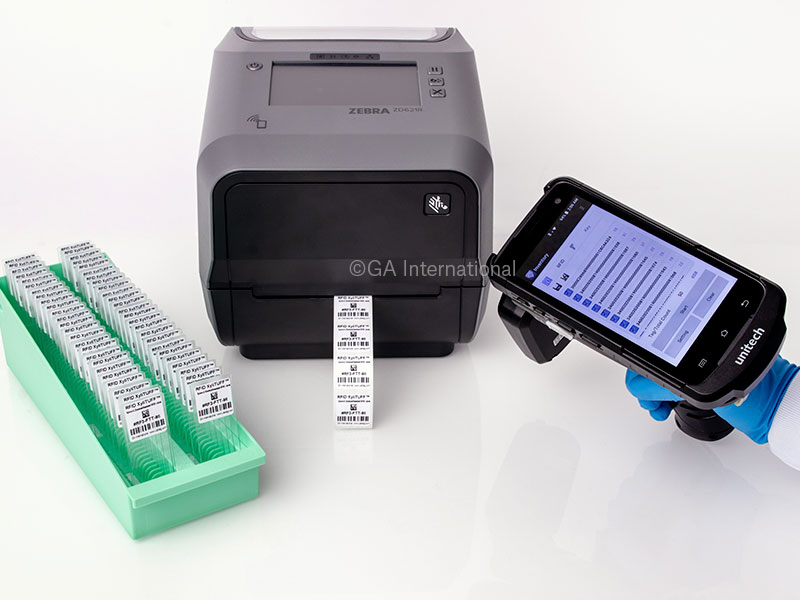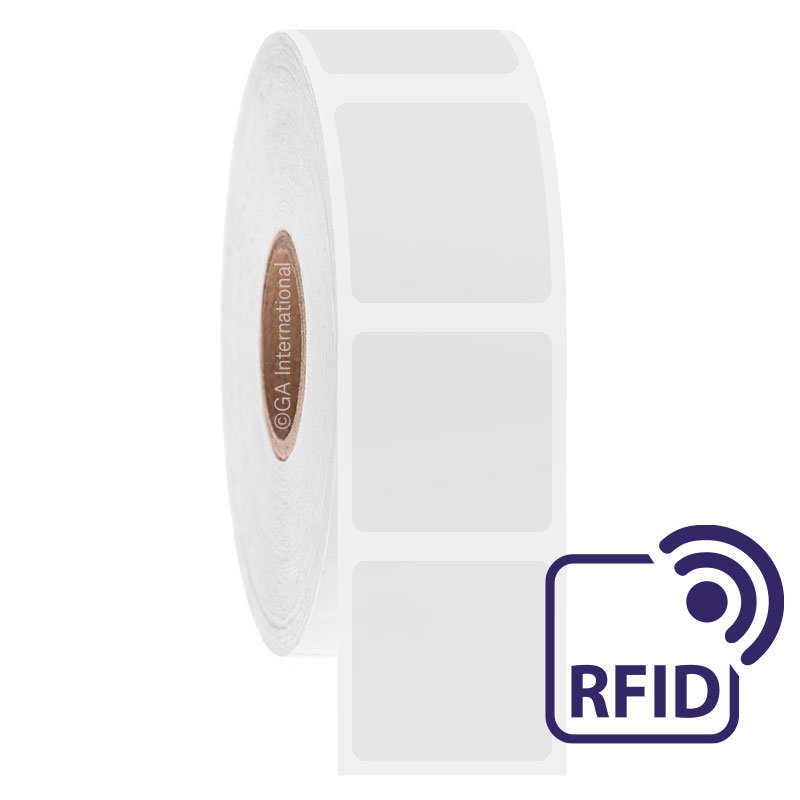Description
RFID XyliTUFF™ – Xylene & Chemical-Resistant RFID Labels
- 12” omnidirectional read range*, without direct line-of-sight ensures quick, easy, and accurate reading from every angle
- Read multiple labeled microscope slides at the same time, even when fully immersed (up to 1”/25mm**)
- Excellent stain resistance, ideal for microscope slides used in histology
- Recommended for routine as well as special staining protocols***
- Resistant to xylene, xylene substitutes, toluene, hexane, acetone, alcohols, dimethyl sulfoxide (DMSO), methyl ethyl ketone (MEK), acetonitrile (ACN), and other common solvents
- Compatible with automated slide processors
We have integrated RFID technology into our xylene and chemical-resistant labels to make a durable RFID label that can withstand exposure to harsh chemicals and solvents. RFID XyliTUFF™ labels are designed for a variety of applications where visual and electronic data require chemical resistance for maximum traceability and regulatory compliance. These labels are especially suitable for histology applications where a high level of sample tracking is needed.
Our RFID XyliTUFF labels have the same robust and chemical-resistant adhesive as our standard XyliTUFF™ labels and will display the same adhesion properties, even in the harshest environments. These labels are intended for use on flat surfaces, with up to 15 hours of xylene resistance on microscope slides. They are equally resistant to the new generation of safer clearing and deparaffinizing xylene substitutes such as Histo-Clear™, Pro-Par, and others.
RFID XyliTUFF labels are compatible with handheld, fixed, and integrated UHF RFID readers. They were specially designed to integrate with specimen or warehouse tracking systems, to improve the identification and monitoring of each item, as well as process efficiency. RFID XyliTUFF labels are intended for histopathology, diagnostic, research organizations, health care, medical centers, anatomic pathologic reagents, equipment and technology solutions suppliers, and wherever sample identification requires a high level of chemical resistance.
When printed with our recommended XAR-class of ink ribbons, the visual and electronic components of these labels resist continuous rubbing with surface sanitizing wipes or harsh chemicals. These UHF RFID labels (Class 1, Gen 2) can be printed and encoded with up to 32 hexadecimal characters of information using dedicated RFID thermal-transfer printers. The printout of these chemical-resistant histology and industrial-grade labels can consist of alphanumeric text, 1D and 2D barcodes, as well as serialized RFID or printed data.
RFID XyliTUFF label size can be customized upon request.
* Read range can vary according to the RFID reader being used.
** RFID readability tests of labels immersed in histology reagents is strongly recommended prior to use.
*** Labels should not be placed in the microwave as it may affect their ability to be scanned/read.
Specifications
Size: 0.875″ x 0.875"
(22.2 mm x 22.2 mm)
Labels/Roll: 1000 (1″ core), 1000 (3″ core)
Perforated: No
Temperature Range: -80°C to +120°C
(-112°F to 248°F)
Adhesive: Permanent
Printing Methods: Thermal-Transfer
Features: RFID
Resistances: Xylene & Chemicals
Recommended Ink Ribbons: XAR-Class
Class: RF3-FTT
Color(s): White
Reviews
Frequently Asked Questions
Yes, RFID XyliTUFF labels are thermal-transfer printable and require an ink ribbon to be printed. To achieve the proper printout, these labels require a xylene and solvent-resistant XAR-Class ink ribbon of the same width or larger.
Yes, an RFID printer can accurately encode these labels when printing. We recommend the Zebra ZD621R UHF RFID thermal-transfer printer.
Yes, specialized software is required to properly encode your labels. We would recommend BarTender Pro and ZebraDesigner3 Pro.
RFID XyliTUFF has been tested and can withstand immersion in xylene for up to 15 hours.
Yes, as RFID XyliTUFF labels do not acquire colors from histological stains such as hematoxylin or eosin Y.
Yes, our RFID XyliTUFF labels are compatible with automated stainers. For more information, consult our technical support team.
Yes, RFID XyliTUFF labels are resistant to the standard histopathology protocols. They have been tested and can be exposed to 70°C/158°F dry heat, H&E staining, ethanol concentration gradient, and xylene immersion.
No, RFID XyliTUFF is not suitable for IHC or antigen retrieval protocols. RFID technology is not compatible with microwave-based protocols.
Yes, an RFID reader is required to access the encoded data. It can be handheld, fixed, and integrated. We recommend the Unitech Handheld UHF RFID Reader for mobility, reach, and ease of use. This reader can read the UHF RFID chip and scan 1D and 2D barcodes.
Place the UHF RFID reader at a maximum of 12” (30.5 cm) away from the sample in any direction. However, the read range can vary according to the RFID reader being used.
Yes, RFID XyliTUFF labels can be read while the labeled microscope slides are fully immersed (up to 1”/25 mm) in xylene, most xylene substitutes, and most staining reagents when using our recommended UHF RFID reader. Prior testing of RFID readability while immersed in other liquids is strongly recommended.
Yes, RFID XyliTUFF labels are compatible with both regulations. Interrogate these labels with a UHF reader capable of reading the frequency band.
No, these labels employ UHF RFID technology and thus cannot be interrogated in another band frequency apart from NFC RFID labels. Thus, a dedicated UHF RFID reader is needed. For XyliTUFF labels customized with NFC RFID technology, contact our technical support team.
The UHF RFID chip (Class 1, Gen2) of the RFID XyliTUFF labels can be encoded with up to 32 hexadecimal characters.
Yes, RFID XyliTUFF™ contain read-write UHF RFID chips. Thus, you can rewrite the EPC memory bank up to 100,000 times if the permalock feature is not active.
Yes, you can scan/read multiple RFID XyliTUFF labels at the same time within the interrogation timeout (in seconds), even without a direct line-of-sight of the UHF RFID reader.
No, RFID XyliTUFF labels are battery-free. These labels don’t require a battery to be functional because they employ passive RFID technology.
Barcoding or label design software can be used to create templates that conform to the size of your label. You can then insert design elements within the template for easy printing.
Yes, we can provide our RFID XyliTUFF labels preprinted with full-color graphics and logos, as well as variable or serialized information from a database. Learn more about our custom printing options.
Please consult our technical support team for details regarding custom encoding and other customization options, such as size.
Resources
Recommended Products
-

Zebra ZD621R UHF RFID Thermal-Transfer/Direct Thermal Printer #ZD621R
0 out of 5Contact Us to Purchase Buy -

BarTender Professional Printer License (Requires Application License) #BTP-PRT
0 out of 5Contact Us to Purchase Buy -

Cryogenic RFID Labels for Thermal-Transfer Printers – 1.25″ x 0.875″ #RF3-JTTA-9NP
0 out of 5$0.00 usd View Product
Related Products
-

Xylene & Chemical-Resistant RFID Labels – 4″ x 2 ” #RF3-FTT-62NP
0 out of 5$0.00 usd View Product -

Xylene & Chemical-Resistant RFID Labels – 2″ x 1″ #RF3-FTT-28NP
0 out of 5$0.00 usd View Product -

Xylene & Chemical-Resistant RFID Labels – 1.5″ x 1″ #RF3-FTT-504NP
0 out of 5$0.00 usd View Product


























